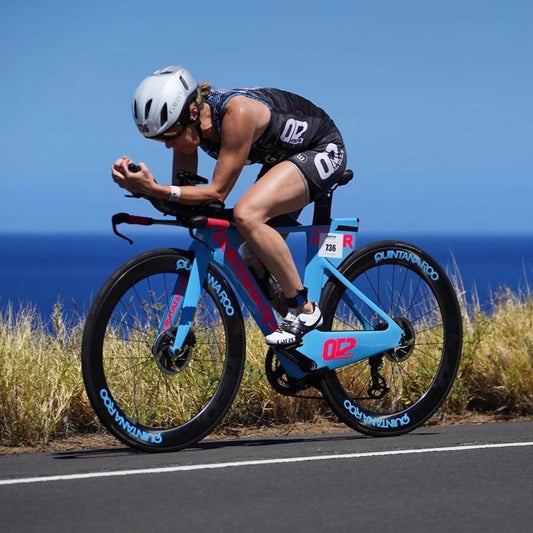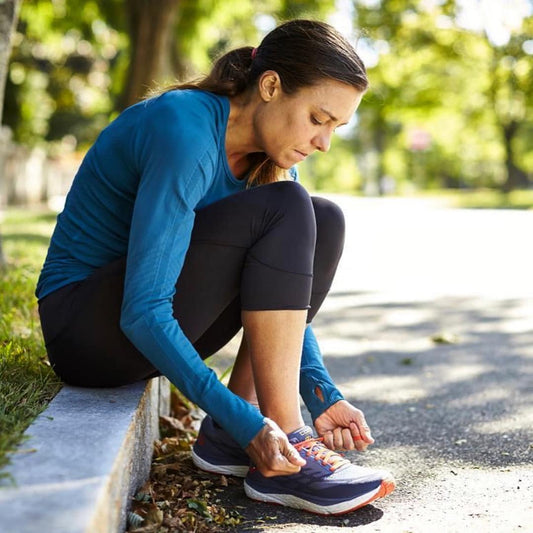The temperatures drop; the fires roar. Winter is time to snuggle under a blanket and sip on tea. Best way to survive winter? Hunker down and stay inside until the frost melts! Growing up in the south, this was definitely my point of view. However, after more than 20 years living in Vermont, I have learned this mentality couldn’t be further from the truth.
Best way to enjoy winter and beat cabin fever? GET OUTSIDE! Not a skier or snowboarder? No problem! I live in a place where winter starts as early as Halloween and lasts beyond Easter. It’s definitely not the easiest place to train as a triathlete. Winter forces us indoors for many activities yet running is one that allows us to get some fresh air and Vitamin D! With so many restrictions this last year (thanks Covid!), our access to exercise has been limited and our ability to socialize is practically non-existent. Running outdoors allows you to meet up with others and still remain safely distant but enjoy the fellowship of your like-minded friends. I probably don’t need to remind you that outdoor running and exploring tends to be so much more enjoyable than running in place on a treadmill…with a mask on. No thanks!
Okay, so we have covered the benefits of outdoor running, now let me help you dress for success! When deciding how to dress, check the temperature and wind chill. Take the wind chill (“feels like”) temperature and add 10 – 20 degrees to that number to determine how you should dress. You should start out the run just a bit chilly, knowing that you will warm up quickly! Below is my head-to-toe guide on running outside in cold temperatures:
Head
- Insulated ear warmers and/or hat. Most heat escapes through your head so you want to do what you can to keep that heat inside! There are many brands out there with ranges of insulation. I personally love my Skida gear which is made right here in Vermont.
Face
- Sunblock (yes you can still get sun in the winter and it is even more intense with the reflection off the snow).
- Skin protectant – for those super cold or windy days when you want to avoid frostbite or windburn. Products like BeautyCounter Cleansing Balm, Dr. Barbara Sturm Ski Cream work great as do many drugstore products like Vaseline, Aquaphor or Vaniply.
- Balaclava – for those super cold days when you want to limit the amount of exposed skin on your face.
Neck
- Neck gaiter – fleece or brushed depending on how much warmth you need. Skida and Turtlefur are two popular options.
Body
- Layers are key! Start with a sweat wicking base layer to move moisture away from your body. Then add a mid-layer for warmth. Finally, if it is really cold or windy, add a wind-blocking outer layer. Many running brands and Nordic ski brands provide these options. Check your local running or ski store to see what works for you!
Hands
- Mittens – definitely warmer than gloves. For added warmth, you can add a thin glove underneath your mittens. I prefer to buy mittens that are designed for cross-country skiing because they keep your hands warm even when they get sweaty.
Legs
- Tights or Running Pants. In really brisk temperatures (below 20 degrees or so), I like to wear silk, wool or synthetic long underwear as a base layer. I then add brushed or lined running tights/pants for added warmth and wind protection.
Feet
- Running socks – sweat wicking cushioned socks tend to work well for me. Wool socks like DarnTough or Smartwool are great for warmth and moisture wicking as well. Make sure your sock come up high enough to go under or meet your running pants so that you don’t have exposed skin at the ankles.
- Shoes with added traction or spikes. Many running shoe brands make GTX versions of their popular running shoes. GTX adds GoreTex for weather protection through snow and slush. GTX shoes often have better traction as well. Icebugs is a shoe brand that is made specifically for winter running; the spikes come out when you need added traction and retract when you hit clear pavement. I personally like to run in the shoes I know work well for my running form, so I add traction on to my shoes. Two popular brands are YakTrax and Kahtoola. They slide on your regular running shoes and you can easily remove them if you find clear pavement during your run. I prefer to wear my lighter weight shoes when I wear these so that I don’t feel quite so clunky with the added weight.
Still not sure what to wear? Runners’ World has this great grid that breaks it down based on temperature. Check out this quick guide for suggestions:
What to Wear Running in the Cold (credit: “Everything You Need to Know about Running in the Cold”, by Susan Paul and Runner’s World Editors, December 2020)
- 60+ degrees: tank top and shorts
- 50–59 degrees: short sleeve tech shirt and shorts
- 40–49 degrees: long sleeve tech shirt, shorts or tights, gloves (optional), headband to cover ears (optional)
- 30–39 degrees: long sleeve tech shirt, shorts or tights, gloves, and headband to cover ears
- 20–29 degrees: two shirts layered—a long sleeve tech shirt and a short sleeve tech shirt or long sleeve shirt and jacket—tights, gloves, and headband or hat to cover ears
- 10–19 degrees: two shirts layered, tights, gloves or mittens, headband or hat, and windbreaker jacket/pants
- 0–9 degrees: two shirts layered, tights, windbreaker jacket/pants, mittens, headband or hat, ski mask to cover face
With proper gear on, let’s now discuss how to have a successful winter run. There are several tips that will help with pre, during and post run.
Pre-Run
- Plan a route that has shorter loop options in case you’re not dressed properly. This will give you an option to grab or shed layers at your start point if needed.
- Grab reflective gear and possibly a head lamp if you are running pre-dawn or pre-dusk. Safety first!
- A proper warmup is key to make sure your muscles are loose and limber. An indoor dynamic warmup is extremely helpful. Start by doing 10-20 pulling knee to chest, steps with leg alternating quad stretch, side lunges, backward lunges, grapevine with exaggerated trunk twist, and hip circles. You can follow this with foam rolling if you need more.
During the Run
- Allow your body to warmup within the first mile to 10 minutes. Don’t force effort or heart rate up. Allow it to happen naturally.
- Start your run into the wind. This way you won’t get too chilled running into the wind when you are sweaty.
- Adjust goals. You will most likely run more slowly (even a minute a mile slower) than you regular pace at a certain heart rate as the footing can be slippery and precarious. Focus on your time for the run at your goal heart rate and not the mileage or pace. You are getting a ton of strength training as you run through snow!
- Nutrition is STILL key. You may not feel thirsty running in colder temperatures, but your body still needs the hydration, electrolytes and calories. Speak with your coach or a registered dietician on what your body needs for the run and stick to a plan of drinking and eating at regular intervals. Be sure you keep liquids and nutrition close to your body (under your outer layer) to avoid freezing!
- Choose fresh snow or pavement over packed snow or ice for better traction. Lower your steps and increase your cadence to avoid muscle strain.
- Have fun! Enjoy the winter wonderland around you!
Post-Run
- Get out of your wet clothes as soon as possible.
- Take a hot shower if needed to warmup. Drinking warm liquids like soup, hot cocoa or tea can be helpful too.
- Enjoy your recovery snack
- Foam Roll and stretch
You now have all the tools you need to enjoy your winter of running. Enjoy the moment and feel proud of your grit running through the elements! I promise you will find running a lot more enjoyable when you get outdoors. Save your indoor running (track or treadmill) for days when it’s sheer ice, speed workouts where leg turnover is key and short transition runs off the bike. Otherwise, get out there and channel your inner polar bear!
This post was written by QT2 Coach, Courtney Kutler.






